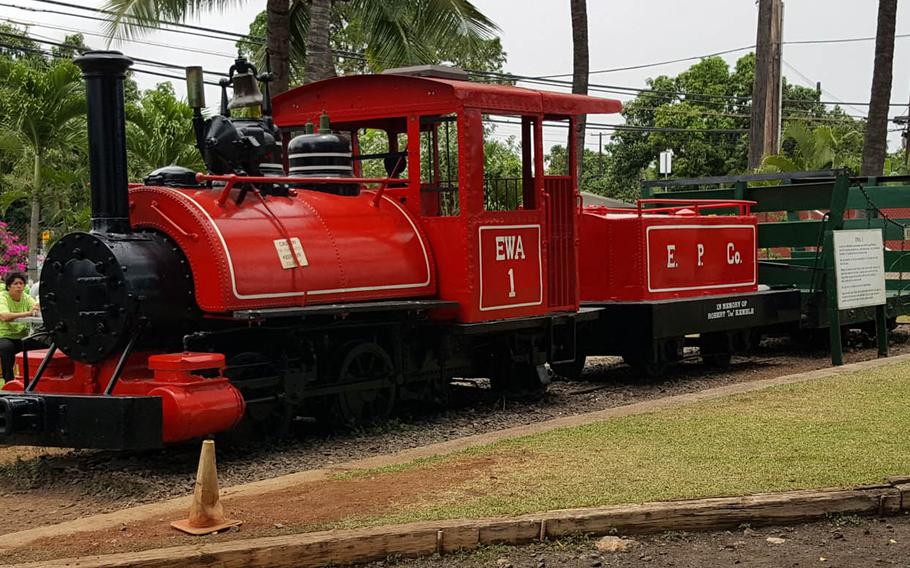
The Ewa 1 steam locomotive was used on the vast Ewa Sugar Plantation in the late 1800s and 1900s on Oahu, Hawaii. (Wyatt Olson/Stars and Stripes)
If you want to get off the beaten track on Oahu, then get on the beaten track. Railroad track, that is.
The nearly 7-mile stretch of track used by the Hawaiian Railway harkens back to a time when Hawaii was all about raising sugar cane and pineapples instead of trendy hotels and international tourism. It’s the only train running on the island.
On weekends you can take the roughly 13-mile roundtrip along Oahu’s western coastline at the blazing top speed of 15 mph, the fastest the vintage locomotive and cars are allowed to travel.
But, of course, speed isn’t the point here. This is a glimpse into Oahu’s past, when the western plains of Oahu were vast crop fields instead of suburban homes and strip malls.
The train is operated by the Hawaiian Railway Society, which also maintains displays of several old locomotives that were used during the heyday of rail in Hawaii. The nonprofit worked to get a section of the once-lengthy network of tracks placed on the state and national historical registries. It has restored about 6.5 miles of track, with plans to restore more.
The Hawaiian Railway uses three restored vintage diesel locomotives, and three roundtrip rides are offered on weekends.
Just finding the depot — which is also the headquarters of the rail society — is an adventure in itself. It’s nestled off a tiny lane in the Ewa plain in a mostly undeveloped spot where it seems time has stood still compared with the many new subdivisions built in this area about 20 miles west of Honolulu.
The centerpiece display at the depot lawn is the Ewa 1 steam locomotive, a bright-red engine that was used on the Ewa Sugar Plantation in the late 1800s and 1900s on Oahu. The plantation used seven different locomotives in the decades it raised and harvested sugar cane, but this is the only one that has been preserved.
This engine is a hit with kids because they’re allowed to climb into the engineer’s cabin and pretend they’re in charge. I was chaperoning a preschool class during my visit, and it seemed most would have been quite content to spend all their time playing inside the Ewa 1.
Another locomotive on display, the Kauila 6, was built in 1889, and was the first locomotive used by the Oahu Railway and Land Company.
Inside the ticket office is a small display of railway artifacts, such as ride tokens, padlocks and keys.
The 90-minute train ride is narrated, with the guide explaining the history of rail in Hawaii, points of interest being passed and the goals of the railway society. The narration, however, can be hard to hear over the rumbling of the rail cars. If this information is of great interest to you, make sure you sit close to a speaker.
The ride itself takes you through some of those new subdivisions, as well as land that’s only now being converted from agriculture to housing. As the train approaches intersections with roads, two conductors jump out and wave traffic to a stop with orange flags. The train is a strange creature in a land now ruled by the automobile.
One conductor wears the old style of striped overalls and hat.
The last mile of track hugs the shoreline, where huge waves crash against small cliffs and then gives way to white-sand beaches. It’s at this point the plain gives way to the mountains of west Oahu.
The train cars, built in the 1940s and originally used by the Army, are open air with bleacher seating so you do get a bit of the no-frills ride that must have been common when sugar cane was king here.
Every second Sunday of the month a ride is offered in the much more opulent Parlor Car 64, which seats only 14 passengers. It was built in Honolulu in 1900 by Benjamin Dillingham, the founder of Oahu Railway and Land Company, as a car for his personal use.
Reservations are required for this ride, which costs $25 per person.
The youngest children might find an hour-and-a-half train ride a bit too long, and the steady click-clack of the steel wheels over the track does have a hypnotic effect on anyone’s senses.
Still, there’s something about trains that fascinates kids — and always has. Maybe it’s the hooting of the horn as it approaches an intersection. Maybe it’s the power of that chugga-chugga sound or the steel-on-steel grind of wheels and track.
Hawaiian Railway
DIRECTIONS
91-1001 Renton Road, Ewa, Hawaii. From downtown Honolulu, take Interstate H-1 west, then take Ewa exit 5A onto Highway 76 south. Go 2.5 miles and turn right at the Tesoro Gas Station onto Renton Road. Continue for 1.5 miles and then turn left onto a small lane named Philippine Sea. You will immediately cross over a railroad track; the entrance to Hawaiian Railway is on the right through a chain-link fence.
TIMES
3 p.m. Saturdays and 1 and 3 p.m. Sundays. Weekday private charters are available. No reservations; the 180 seats on the train are offered on a first-come, first-served basis. Rides are 90 minutes long. Ticket sales and gift shop open at 11:30 a.m.
COSTS
Adult $12; children ages 2 to 12 $8; ages 2 and younger free
FOOD
No food or beverages are sold at the railroad depot. However, the 3 p.m. rides top near an ice cream stand on the return trip. There are picnic tables on the depot lawn.
INFORMATION
Phone: (808) 681-5461; website: www.hawaiianrailway.com